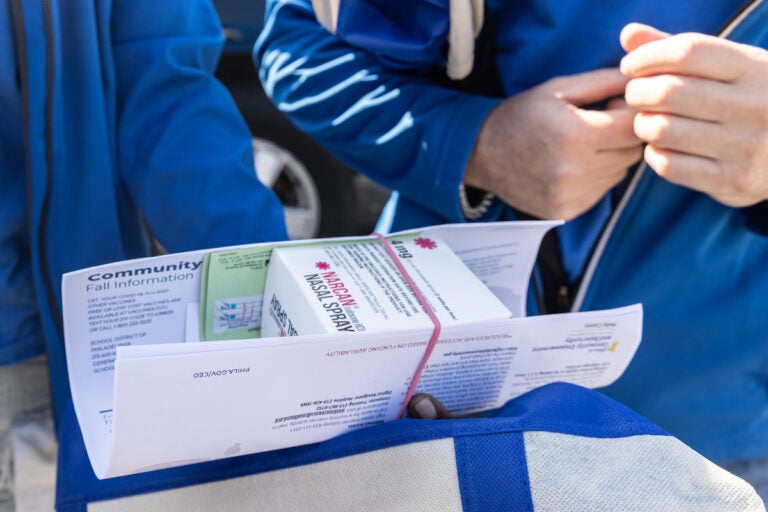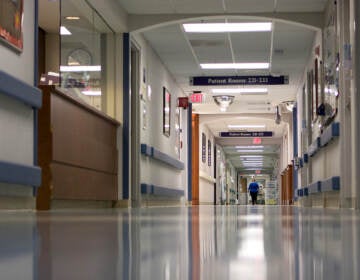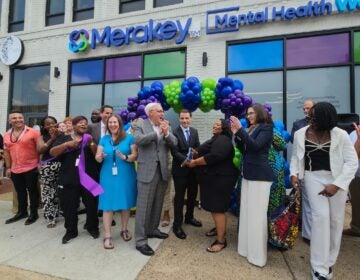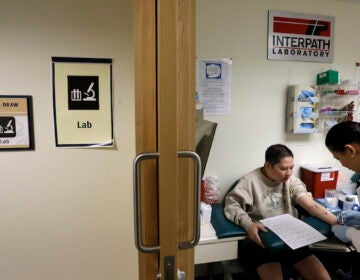Philly’s system for treating opioid use disorder is fragmented, study finds
Researchers at Thomas Jefferson University found that Philadelphians living with substance use disorder say housing, language and transportation are some barriers to services.

File photo: An opioid crisis resource kit containing Narcan, fentanyl test strips and information on how to get addiction treatment and more harm reduction resources. (Kimberly Paynter/WHYY)
A new study is drawing a detailed picture of the opioid use disorder crisis in Philadelphia, and the results are eye-opening.
Using geographic information systems (GIS) mapping and focus groups around the city, researchers at Thomas Jefferson University have found that Philadelphia’s “robust” treatment system is also “siloed” and “fragmented.”
The findings show that individuals living with substance use describe several social determinants of health that create barriers to care. Among those complex needs are transportation, comorbid mental and physical health conditions, wounds, language issues and child care.
“We did a bunch of interviews with people who have accessed the opioid use disorder treatment system in Philadelphia,” said Erin Kelly, assistant professor at Thomas Jefferson University. “And while many had great experiences, many had experienced a lot of barriers both to getting into treatments and staying in treatment.”
This research project was funded by Pew Charitable Trusts last year. Kelly — along with research assistant professor Megan Reed — both conducted this qualitative analysis to provide insights on individuals seeking treatment around the city.
The goal was also to provide foundational research on the capacity of substance use treatment facilities in Philadelphia to provide equitable access and high retention.
“What are the barriers to entering in the treatments in Philadelphia? What are the barriers to staying in treatment in Philadelphia? And what does the system look like as a whole?” Reed said. “We did surveys with methadone providers. We did a bunch of focus groups with people who had accessed the treatment system and then we literally mapped where treatment is and thought a lot about access and transportation.”
Among their findings was that the assessment process for individuals going into treatment — inpatient and outpatient care — was exhausting and arduous, particularly at assessment centers.
“People regularly describe this process as taking up to 18 hours,” Reed said. “And these are people who are trying to get treatment and they’re going through the assessment process while they’re in active withdrawal, which was described as pretty agonizing. And many times people talked about leaving treatment, or leaving the assessment process early, or going through the entire assessment process and being told there are no slots available for you. You need to come back tomorrow.”
Mapping access to care
The report also assessed data provided by the city of Philadelphia Department of Behavioral Health and Intellectual disAbility Services (DBHIDS) to map out locations of care, using GIS mapping.
Of the mapped locations, 26% are ones that the Substance Abuse and Mental Health Services Administration (SAMHSA) lists as treatment for individuals with private insurance. Twelve programs within the city limits accept public insurance.
The report also showed that within Philadelphia, there’s a sizable concentration of facilities that offer American Society of Addiction Medicine (ASAM) levels of care.
“There are some levels that have a great deal of facilities like a 3.5 which is most common of the inpatient facility type. Also, the 1.0’s, which might provide both buprenorphine or methadone,” said Kelly. “12 include methadone.”
The bigger issue is that they’re mostly located within Center City, she said.
“And if you live in certain parts of the city — towards the Northeast, towards the Northwest and in West Philadelphia — there may or may not be that much access to care in those regions, especially if you need to access more than one level of care,” she said.
Kelly said that it’s a pervasive issue among the people they served.
“Especially those who are staying in a methadone program, they need to go every day to get their medication, and the amount of time that it takes to get to these facilities becomes pretty critical,” she said.
Kelly said that they also looked at where services were offered — in which neighborhoods — while analyzing demographics like race and ethnicity.
“Although historically, we think of this as being a crisis that has affected white people,” she said, “we’ve seen … a lot of the locations of care are actually predominantly within Black neighborhoods, and they’re sort of on the outskirts of white neighborhoods.”
Language as a barrier to care
Another barrier is language. Megan Reed called access to care for Spanish speakers “not good.”
“We had a focus group with Latino people that was in a recovery house,” she said. “We held that focus group in Spanish, and they gave many instances of experiencing discrimination. And even when the care was good, they weren’t able to, for example, go to groups with other people. They weren’t able to fully participate in that. There’s a huge lack of bilingual staff across treatment programs. Whatever the treatment type is.”
In one meeting, a community member talked about the process of trying to get methadone treatment.
“One man described being in the jail system here in Philadelphia and said that it had taken him three weeks to get back on his methadone dose — even though he’d been on methadone before he went into jail — because he couldn’t speak to anybody and communicate that he was a methadone patient,” she said. “So that really compromised his recovery process.”
Policy recommendations
Reed and Kelly concluded their study with a set of policy recommendations, including increasing financial, housing and transportation services; expanding alternative treatment locations; increasing inpatient treatment slots; and supporting increased use of telehealth.
“It’s really important to meet people where they’re at and to give them that person-centered care,” Reed said. “It’s very important that we keep giving out Narcan, test strips, syringes and other services to people and those can be great entry points into treatment themselves. If somebody’s being provided with really empathetic care who’s actively using substances, they’re more likely to trust that people providing that care to link them into treatment. So I think continuing to support harm reduction programs in Philadelphia is incredibly important.”
And these recommendations will be taken to City Hall.
“We’ve had that longitudinal relationship with DBHIDS city of Philadelphia Department of Behavioral Health and Intellectual disAbility Services” said Reed. “But we’re also hoping to get it in front of City Council and the Parker administration as well.”

Get daily updates from WHYY News!
WHYY is your source for fact-based, in-depth journalism and information. As a nonprofit organization, we rely on financial support from readers like you. Please give today.








